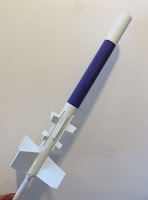In a grumpy old man voice: "You kids don't know how good you've got it! In my day we had to cut out our own fins! Then things got easier when they started die-cutting the balsa."
To be honest, die-cut balsa was never that great. We used to call it "die-crushing". If the shop blades were old you'd spend some time freeing up the pieces with your X-Acto knife.
The kit from the 1990s was a good example of dull blades. Here I'm flexing the die-cut balsa just to find the fin edges.
Here's how some of the cross grain leading edges could separate. You definitely don't want to punch these fins from the sheet.
From the older kit you can see how different the fins are. Here you do have to "gang sand" die cut fins to get a consistant size.
With laser cut fins there really isn't a reason to gang sand, they should be identical. You should remove the blackened, burnt edges though.
Here's the old and new, side by side.
The old kit instructions say to leave the fin edges square. The reissue kit says to round the leading edges.


















































